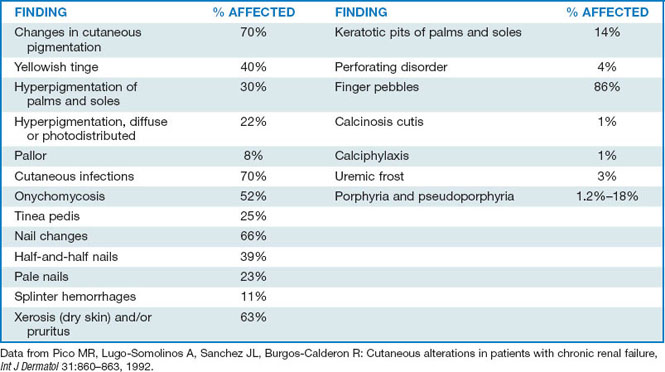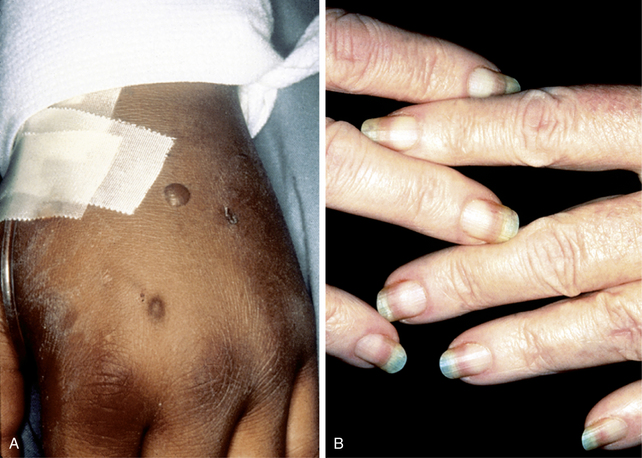Chapter 38 Cutaneous manifestations of renal disease
1. What types of skin changes are associated with renal disease?
There are three main categories of skin disease associated with renal diseases:
• Systemic diseases with prominent renal and cutaneous manifestations (e.g., Henoch-Schönlein purpura)
3. Do cutaneous signs of chronic renal failure resolve when the patient is treated with hemodialysis?
4. What cutaneous findings are present in patients being treated with dialysis?
Many of the skin changes described in patients with chronic renal failure are also found in patients with renal failure undergoing treatment with either peritoneal dialysis or hemodialysis. A high percentage of patients receiving dialysis complain of pruritus that may be severe. In some instances, the pruritus worsens with dialysis. Patients on renal dialysis may develop a bullous eruption similar to porphyria cutanea tarda (Fig. 38-1A). Acne has been described in association with dialysis and therapy with testosterone. Several perforating diseases are associated with chronic renal failure, with or without renal dialysis, including Kyrle’s disease, reactive perforating collagenosis, and perforating folliculitis. Some authors group all of the perforating diseases seen in these patients under one term—acquired perforating dermatosis of chronic renal failure. The pathogenesis of these conditions is not understood. Dialysis patients may also develop cutaneous complications from this treatment, such as infections or contact dermatitis in the area of the peritoneal cannula or arteriovenous fistula.
Fuchs E, Lynfield Y: Dialysis acne, J Am Acad Dermatol 23:125, 1990.
5. Describe the nail changes in chronic renal failure.
Both half-and-half nails and Muehrcke’s nails are associated with chronic renal failure. In half-and-half nails, the proximal half of the nail is white, and the distal portion retains the normal pink color (Fig. 38-1B). This is believed to be due to edema of the nail bed. Muehrcke’s nails are associated with hypoalbuminemia and have two transverse parallel white bands, separated from each other and from the lunula by areas of normal pink nail.
6. What is uremic frost?
Although a rare finding today, this discoloration of the face was originally described as a classic manifestation of chronic renal failure. Whitish deposits were noted about the face and neck, believed to be due to deposition of crystallized urea from sweat. Table 38-2 summarizes the abnormalities of skin color associated with renal failure.
Walsh SR, Parada NA: Images in clinical medicine. Uremic frost, N Engl J Med 352:e13, 2005.
8. What causes the pigmentary changes of the skin seen in chronic renal failure?
It is the result of increased amounts of melanin present in the basal layer of the epidermis and superficial dermis. It has been proposed that such patients have decreased metabolism of β-melanocyte–stimulating hormone (β-MSH) by diseased kidneys, leading to elevated plasma levels of β-MSH, a hormone that stimulates melanocytes to produce more melanin.
Stay updated, free articles. Join our Telegram channel

Full access? Get Clinical Tree











